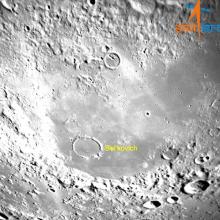Listen to today's episode of StarDate on the web the same day it airs in high-quality streaming audio without any extra ads or announcements. Choose a $8 one-month pass, or listen every day for a year for just $30.
You are here
Moon and Antares
Before astronauts landed on the Moon, space artists often depicted the lunar mountains and craters as harsh and jagged. The reality turned out to be less dramatic, though. Mountains and crater rims tend to be soft and rounded — far more subdued than most of the similar features here on Earth.
The reason is a process called space weathering. It works like the weathering here on Earth, where wind and rain erode geologic features. On the Moon, though, the weathering is produced by the solar wind and a “rain” of space rocks.
The Moon has almost no atmosphere to protect it from the rest of the universe. As a result, it faces a non-stop bombardment from outside.
The solar wind, for example, is a high-speed flow of charged particles from the Sun. As the particles hit the surface, some are embedded in grains of the lunar “dirt,” known as regolith. Among other things, that can create molecules of a compound that’s similar to water.
Space rocks produce more obvious effects. Big ones gouge big impact craters, and blast debris all across the Moon. But the Moon is hit by billions of tiny space rocks as well. Across billions of years, that non-stop rain has pulverized much of the surface, creating the powdery regolith. And it’s helped wear down the lunar mountains and craters — giving them a gentle profile.
Look for the Moon before and during dawn tomorrow. Antares, the bright orange heart of the scorpion, is close to its lower right.
Script by Damond Benningfield





